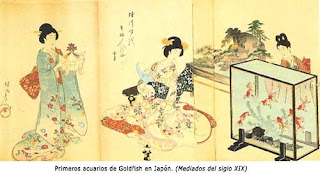A little history
In ancient China , various species of carp ( collectively known as Asian carps ) were domesticated and have been reared as food fish for thousands of years . Some of these species are normally gray or silver and have a tendency to tonarse with red, orange or yellow , which was first recorded in the Jin Dynasty ( 265-420 ) . During the Tang Dynasty ( 618-907 ) , it was popular to raise carp in ornamental ponds and water gardens . A natural genetic mutation caused a golden color (actually yellowish orange ) rather than silver coloration . People began to breed the gold variety instead of the silver variety , keeping them in ponds or other bodies of water. On special occasions when guests were expected , the fish could be moved to a much smaller containerEnvironmental Alert
Because of its invasive potential or susceptibility to become a serious threat to compete with native wildlife species , altering their genetic purity or the ecological balance, this species has been included in the List Spanish Invasive Alien Species , approved by Royal Decree 1628 / 2011, of November 14 , is forbidden in Spain its introduction into the natural environment throughout the country and in marine areas jurisidiccionales except by administrative authorization isolated from natural enclosures linked to human activity .Coloration
The goldfish is available in different colors . These can be monochrome : Black , red, gold , blue , matte , albino , Bicolor , Calico ( All colors in patches , in a black base ), Tricolor and Panda . The latter is no longer a color transition period , ie changing its current color to a permanent one .Facilities required to have a Goldfish
To have a single fish , we need at least 40 liters aquarium in this fish pond being the norm does not apply 1 liter per cm of fish. Yes we have two fish need an aquarium of 80 liters. You can also keep small ponds , as an alternative to koi . When they are small they can be kept in a tank of about 1.5 liters per cm of fish.WE NEVER PUT AN GOLDFISH IN A FISHBOWL AND THAT IS DEADLY TO ALL FISH .We must also put the aquarium , we will need :· Internal or external filter (preferably with aerator )· Thermo heated ( opcinal )· Sifonador· Aerator (if it brings built-in filter )· Gravel· Plants (optional )· Caves or hiding somewhereThe process of preparing the tank is explained here http://amigosdelospeces.blogspot.com.es/2013/09/mi-primer-acuario.htmlMy temporary pond where at the moment I have two small goldfish comet is simply a box multipurpose 6 euros, this model is 25 liters ( 23 liters real). Then I added all accessories except the thermos heater , because in the future will live in a pond all year . As you will see they have a powerful oxygenator ( the green hose ) , as this species requires . They also have a seedling tetra artificial art ( do not want to advertise ) that alcampo costs 3 euros and a recycled broken tupperware , these would be the fish hiding using sleeping or if they see any threat. Tmabién have two sticks of lucky bamboo to remove the maximum amount of nitrite. The gravel is purchased in bulk and are roughly about 3 kilos , and smaller stones I could find.
Hiro using tupperware to hide while Fred prefers the artificial seedling .
The two little ones hidden in the ground
Basic Care
The temperature should be between 15 and 22 º C. If these limits are exceeded the fish may suffer stress, and become predisposed to diseases.Ideal water conditions in the aquarium goldfish consist of a pH of 6.8 to 7.6. Can survive at a pH as high as 8.0 . I I have to mine with pH 7.4 . without any problem.They prefer moderately hard water but can live in water very soft to very hard . Ammonia poisoning is very harmful in the goldfish . The earliest symptoms are reddish veins in the fins .Goldfish are much more fragile than other varieties of fish , given the special care they require : high oxygen levels and a balanced diet that combines both plant and animal nutrients .The ten golden rules of goldfish care :Do not feed more . Give them what they can eat in two minutes .
Do not keep them in tight spaces. At least 35 liters per fish when they are of medium size.
Do not overpopulate your aquarium . See the previous point .
Monitor the water parameters .
Do not buy a fish if we are unwilling to care for their special needs.
Provide the fish live food occasionally .
Seek help when necessary.
Changes 20% water once a week.
Do not keep goldfish with tropical fish.
Of buying commercial feed should this be special for goldfish, tropical fish not .Following this, the chances are that your fish live happily for a long time :)











